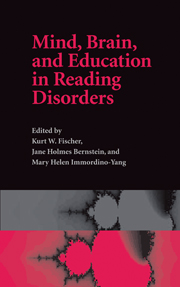Book contents
- Frontmatter
- Contents
- List of figures
- List of tables
- List of contributors
- Acknowledgements
- Part I What is Reading, and What are Reading Disorders? Looking to Neuroscience, Evolution, and Genetics
- Part II Reading and the Growing Brain: Methodology and History
- 4 A brief history of time, phonology, and other explanations of developmental dyslexia
- 5 Approaches to behavioral and neurological research on learning disabilities: in search of a deeper synthesis
- 6 Growth cycles of mind and brain: analyzing developmental pathways of learning disorders
- Essay: Cycles and gradients in development of the cortex
- 7 Brain bases of reading disabilities
- 8 The neural correlates of reading disorder: functional magnetic resonance imaging
- 9 Patterns of cortical connection in children with learning problems
- Essay: The role of experience in brain development: adverse effects of childhood maltreatment
- Part III Watching Children Read
- Part IV Reading Skills in the Long Term
- Appendix: Transcript and behavioral data from Profiles in Reading Skills (Four Boys)
- Index
- References
Essay: The role of experience in brain development: adverse effects of childhood maltreatment
Published online by Cambridge University Press: 22 September 2009
- Frontmatter
- Contents
- List of figures
- List of tables
- List of contributors
- Acknowledgements
- Part I What is Reading, and What are Reading Disorders? Looking to Neuroscience, Evolution, and Genetics
- Part II Reading and the Growing Brain: Methodology and History
- 4 A brief history of time, phonology, and other explanations of developmental dyslexia
- 5 Approaches to behavioral and neurological research on learning disabilities: in search of a deeper synthesis
- 6 Growth cycles of mind and brain: analyzing developmental pathways of learning disorders
- Essay: Cycles and gradients in development of the cortex
- 7 Brain bases of reading disabilities
- 8 The neural correlates of reading disorder: functional magnetic resonance imaging
- 9 Patterns of cortical connection in children with learning problems
- Essay: The role of experience in brain development: adverse effects of childhood maltreatment
- Part III Watching Children Read
- Part IV Reading Skills in the Long Term
- Appendix: Transcript and behavioral data from Profiles in Reading Skills (Four Boys)
- Index
- References
Summary
Connection: One of the most important generalizations in developmental neuroscience is that the brain shows remarkable plasticity in its development, with the plasticity typically greatest at early ages (Diamond & Hopson, 1998; Huttenlocher, 2002). One aspect of plasticity is change in the connectivity of different brain regions. Both biological factors and vivid experiences can powerfully shape brain connectivity and other aspects of brain development. Just as learning disorders may involve reduced connectivity of specific cortical regions, so maltreatment seems to reduce cortical connections, both within the left hemisphere and between hemispheres. Also it affects the functioning of other brain regions, especially in the left hemisphere. Thus the evidence suggests that early experience of maltreatment strongly shapes brain functioning. This essay thus indicates both: (a) that maltreatment can shape brain development and organization, including possibly the development of reading – a topic that is worthy of future research; and (b) that problems in connections between brain regions may be important in various kinds of behavior disorders. This essay also serves as a reminder that children's social histories have implications for their neuropsychological development.
The EditorsChildhood maltreatment has adverse effects on children's functioning and shapes their neural development (Teicher, 2000, 2002). Over the last several years we have been studying the effects of sexual abuse, physical abuse, and psychological trauma on development of the central nervous system (CNS) in children and adults. We have found that there are a number of vulnerable targets.
First, the left hemisphere seems to be disproportionately affected.
- Type
- Chapter
- Information
- Mind, Brain, and Education in Reading Disorders , pp. 176 - 178Publisher: Cambridge University PressPrint publication year: 2007
References
- 2
- Cited by

